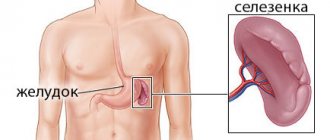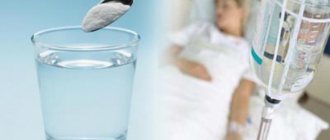Causes of gastroenteritis in adults
Gastroenteritis in adults (acute form) can be caused by a number of reasons: viruses, bacteria, allergies or poisoning. Let's look at each of them.
Viral gastroenteritis. Caused by various viruses (most often gastroenterovirus and rotavirus). Another name for viral gastroenteritis in adults is intestinal flu (an explosive mixture of respiratory and intestinal infection, accompanied by high fever, vomiting, and stool upset). However, with timely treatment, all symptoms disappear completely within a week.
Bacterial gastroenteritis. This includes dysentery, cholera, and salmonellosis. Bacterial gastroenteritis in adults is very severe; due to frequent vomiting and repeated watery stools, dehydration quickly occurs, so urgent treatment is required (most often in a hospital, under the supervision of doctors), which is primarily aimed at replenishing fluid in the body, and also includes antibiotic therapy.
Allergic gastroenteritis. Most often it occurs as an atypical form of an allergic reaction to certain foods or medications.
Toxic gastroenteritis. Occurs as a result of poisoning with toxic chemicals, poisonous fish, berries or mushrooms. It is considered one of the most severe forms of gastroenteritis, as it leads to severe intoxication of the entire body. Treatment of toxic gastroenteritis is carried out only in hospitals, under the supervision of doctors.
Alimentary gastroenteritis. It develops as a consequence of poor nutrition or alcohol poisoning.
To the point
Stomach pain: how to help yourself at home?
Epidemiology
In modern conditions, acute intestinal infections (AI) in children remain a fairly pressing medical problem.
According to WHO, about 1.7 billion cases of acute diarrhea are registered annually in children worldwide, and 525 thousand die from it under the age of five. Every child under 5 years of age experiences at least one episode of ACI [1]. In Russia, acute respiratory infections still occupy a significant place in the structure of infectious morbidity, second only to acute respiratory viral infections [2]. In particular, 25 million outpatient visits to a doctor per year were recorded for rotavirus infection. This means that every fifth child visits a doctor at least once a year for gastroenteritis, and one out of 60–65 children is hospitalized with this disease every year. Children in the first 5 years of life most often suffer from rotavirus gastroenteritis, and about 5% of all deaths in children under 5 years of age are caused by rotavirus [3]. Among the causes of childhood infectious mortality, rotavirus infection is in third place after pneumococcal infection and measles. In the United States, acute gastroenteritis (AGE) accounts for about 10% (220 thousand) of children's hospitalizations, more than 1.5 million visits to clinics and about 300 deaths in children under 5 years of age per year [4].
Etiology
The etiological factor of infectious gastroenteritis can be various agents: bacterial, viral or protozoal. Bacterial agents can be representatives of the genera Salmonella, Shigella, pathogenic strains of Escherichia coli, Campylobacter, Staphylococcus, Klebsiella, etc. The causative agents of viral acute infections are rotaviruses of groups A and C, noro-, astro-, adenoviruses F, sapo-, bocaviruses, aichi viruses, parecho-, coronaviruses, etc. According to research, from 50 to 80% of cases of acute intestinal infections in children are caused by group A rotaviruses and genotype 2 noroviruses [5–7]. In Russia, the frequency of rotavirus gastroenteritis in the structure of the incidence of acute intestinal infections is 7–35%, among children under 3 years of age it exceeds 60% [8].
The most common enteric pathogens according to age in the European Region [9]:
- under 1 year: rota-, noro-, adenoviruses, salmonella;
- 1–4 years: rota-, noro-, adenoviruses, salmonella, campylobacter, yersinia;
- over 5 years: rotavirus, salmonella, campylobacter.
To develop optimal diagnostic and treatment tactics, it is important to understand the pathogenesis of the development of acute intestinal infections in children (Table 1).
As mentioned above, the most common cause of gastroenteritis is rotavirus. The first episode of rotavirus gastroenteritis in children from 6 months to 2–3 years is most severe. The danger of viral gastroenteritis is associated with rapid dehydration and electrolyte disturbances due to the loss of water and salts through loose stools and vomiting.
Clinical assessment of dehydration in children
There are the following anatomical and physiological features in children that predispose to dehydration [11]:
- high water demand;
- large physiological losses of water (breathing, sweating, urination);
- low reserve of proteins, carbohydrates (intracellular homeostasis) due to body growth;
- weakness of adaptive mechanisms (adaptive reactions are pathological).
- physiological immaturity of the liver, kidneys, lungs, intestines, reticuloendothelial system (insufficient detoxification);
- increased sensitivity of the vascular walls of cell membranes to oxygen starvation.
To assess the degree of dehydration, they traditionally focus on fluid deficiency as a percentage of body weight in accordance with WHO criteria [12]:
- <5% – no signs of dehydration;
- 5–10% – moderate degree of dehydration;
- >10% – severe dehydration.
There is also a clinical dehydration scale (total points from 0 to 8; Table 2) [13]
Clinical assessment of dehydration according to these parameters is carried out using a point system: 0 points - no dehydration, 1-4 points - mild dehydration, 5-8 points - moderate/severe dehydration.
A fluid loss of about 5% can be suspected if two of four signs are present [14]:
- prolongation of capillary refill time by more than 2 seconds (capillary test);
- lack of tears;
- dry mucous membranes;
- intoxication syndrome.
The simultaneous presence of three of the listed signs is evidence of fluid loss of more than 10% and the risk of developing hypovolemic shock.
Dehydration syndrome occurs when water and electrolytes are lost. There are three types of dehydration: hypertonic, hypotonic and isotonic [11].
Hypertonic (water deficiency, intracellular) dehydration occurs against the background of loss of predominantly water, which, due to an increase in sodium concentration in the plasma, moves into the bloodstream. Losses occur mainly through diarrhea.
As a result, intracellular dehydration occurs, which is clinically manifested by unquenchable thirst, aphonia, and “crying without tears.” The skin is dry, warm, the large fontanel does not collapse, a high plasma sodium level ≥150 mmol/l, a reduced volume of red blood cells and a high hemoglobin content are characteristic. Plasma and urine osmolality are increased.
Hypotonic (salt deficiency, extracellular) dehydration occurs in the case of predominant loss of electrolytes (sodium, potassium), and occurs when vomiting predominates over diarrhea. Loss of salts leads to a decrease in plasma osmolarity and the movement of fluid from the vascular bed into the cells (intracellular edema). With this type of dehydration, thirst is moderate. External signs of dehydration are mild: the skin is cold, pale, moist, the mucous membranes are not so dry, the large fontanel is sunken. Characterized by a decrease in plasma sodium levels to less than 135 mmol/l, an increase in the volume of red blood cells and a decrease in the concentration of hemoglobin in them. Plasma and urine osmolality are reduced.
Isotonic (normotonic) dehydration is considered the most common and is accompanied by a simultaneous loss of fluid and salts. Typically, plasma sodium levels are normal. The average erythrocyte volume and hemoglobin concentration, plasma and urine osmolarity were within normal limits.
Diagnostics
Diagnosis of OGE is based on characteristic clinical symptoms. According to the European Society of Pediatric Gastroenterology, Hepatology and Nutrition (ESPGHAN) [15], OGE usually does not require specific confirmation. However, in some situations, stool culture, PCR diagnostics and immunodiagnostics may be useful.
The bacteriological method is the “gold” standard for bacterial acute intestinal infections, subject to the key rule: collection of clinical material should be carried out before prescribing antimicrobial therapy. Taking into account the high cost, labor intensity and obtaining research results after 3 or more days, recently it has been proposed to significantly limit its use. ESPGHAN recommends the use of a bacteriological method for the differential diagnosis of infectious pathology and inflammatory bowel diseases in cases of persistent diarrhea requiring antibacterial therapy (immunocompromised patients or suspected shigellosis) [15].
Identification of a specific antigen can be carried out using latex agglutination, coagglutination, immunochromatography, enzyme immunoassay and other methods, which are express methods that allow confirming the diagnosis of bacterial and viral acute intestinal infections in the early stages of the disease, incl. during treatment with antibiotics. In the last decade, the polymerase chain reaction (PCR) method has been increasingly used to verify pathogens, incl. Real-time PCR (RT-PCR). The advantages of the RT-PCR method include high specificity and sensitivity, simplicity and convenience of analysis, the ability to study various biological materials and identify several pathogens in one test tube at once (multiplex RT-PCR), the speed of obtaining results, which makes it possible to classify PCR as a method of early etiological diagnostics [16, 17].
Molecular genetic studies should be considered not as an alternative, but as a mandatory addition to the regulated diagnostic schemes for ACI, allowing for effective verification of the complex of viral pathogens of ACI and assessing the identity of bacterial and viral isolates. Serological methods (agglutination reaction, direct hemagglutination reaction with erythrocyte diagnosticum, etc.), which allow the detection of specific antibodies, are considered auxiliary in the diagnosis of most invasive acute intestinal infections and basic in the diagnosis of yersiniosis [18].
Treatment
The algorithm for the treatment of acute gastroenteritis in children is presented in the figure.
The basis of therapy for patients with OGE, regardless of the etiology of the disease, is the earliest possible oral rehydration with solutions with an osmolarity of 225–250 mOsm/L. Composition of oral rehydration solution per 1 liter (ESPGHAN): Na+ – 60 mmol/l, K+ – 20 mmol/l, Cl- > 25 mmol/l, citrate – 10 mmol/l, glucose – 74–111 mmol/l .
The benefits of oral rehydration include [19]:
- with mild and moderate degrees of dehydration, restoration of the concentration of potassium, sodium and acid-base balance occurs faster than with infusion;
- simplicity and accessibility of the method;
- high efficiency and absence of complications.
According to the ESPGHAN-2014 recommendations, if oral rehydration is not possible, it should be carried out through a nasogastric tube, which is equally effective. It is possible to use a refrigerated or frozen solution, a gel solution, or add flavoring agents or honey to the rehydration solution for oral rehydration.
Indications for switching to parenteral rehydration:
- severe forms of exicosis with signs of hypovolemic shock;
- dehydration + severe intoxication;
- uncontrollable vomiting;
- oliguria/anuria that does not disappear during the first stage of rehydration;
- ineffectiveness of oral rehydration during the day.
If signs of hypovolemic shock develop, the main goal of therapy is to ensure normal cardiac output and preload with normal contractility, so prescribing vasodilators when contractility is reduced may be dangerous.
Goals of therapy in the first hour [20]:
- restoration of consciousness;
- restoration of peripheral tissue perfusion: pale spot symptom less than 2 s, diuresis more than 0.5 ml/kg/h, peripheral and central pulses are equal;
- restoration of blood pressure.
For this purpose, 1 bolus of 20 ml/kg of 0.9% NaCl or Ringer's solution is administered (less than 20 minutes). If there is improvement, further observation; if there is no effect, repeat administration. It is important to achieve normalization of vital functions [20].
If it is impossible to catheterize peripheral vessels, intraosseous access must be provided.
Goals of further therapy include:
- maintaining saturation more than 70%;
- cardiac index more than 3.3 but less than 6.0;
- restoration of perfusion pressure: central venous pressure – 8–12 mm Hg. and mean arterial pressure ≥65 mmHg.
Diet therapy plays a key role in the acute period of the disease. According to modern studies [21, 22], you should not stop feeding for more than 4–6 hours after the start of rehydration, and continue breastfeeding during the course of OGE and rehydration; lactose-free formulas are recommended only for children under 5 years of age who are in a hospital; The use of crackers and rice in the diet of children with OGE is not recommended, because The effectiveness of this diet has not been studied, and drinks high in sugar are not recommended.
As for drug therapy, the use of antiemetic drugs and loperamide is not recommended for OGE [23]. The use of dioctahedral smectite is recommended as sorption therapy [24]; other sorbents should not be used in the treatment of OGE. The antisecretory drug racecadotril can be used in the treatment of OGE, since it reduces secretion of the intestinal mucosa and increases absorption [25].
The ESPGHAN (2014) guidelines do not recommend routine empirical antibiotic therapy.
Indications for antibiotic therapy:
- bacterial gastroenteritis: Shigella spp., Campylobacter spp., Salmonella enterica;
- epidemiological data on possible cholera infection;
- bloody diarrhea with or without fever, which may indicate shigellosis or salmonellosis.
In this case, the use of oral antibiotics is preferable. Parenteral antibiotics are recommended:
- if oral administration is impossible (uncontrollable vomiting, stupor);
- with severe toxemia, bacteremia or suspected bacteremia;
- patients with immunodeficiency, if gastroenteritis is accompanied by fever;
- children under 3 months of age with fever.
In developing countries, it is also recommended to include the microelement zinc in treatment regimens for OHE [26].
Active therapy with probiotics together with oral rehydration reduces the duration and severity of symptoms of gastroenteritis; in particular, probiotics Lactobacillus GG and Saccharomyces boulardii are used for children with OGE [27–30]. Oral administration of probiotics reduces the duration of diarrhea. Data obtained from studies indicate that the inclusion of probiotics in the treatment of viral gastroenteritis provides a better effect than their use by patients with bacterial or parasitic infections. The mechanism of action of probiotics is strain-specific: there is evidence of effectiveness of certain strains of lactobacilli (for example, Lactobacillus casei and Lactobacillus reuteri ATCC 55730) and Saccharomyces boulardii.
Conclusion
Thus, timely and adequate diagnosis and treatment of OGE in children is an important task in the work of a pediatrician. Particular attention should be paid to the treatment of patients with gastroenteritis with a complicated history and premorbid background, in particular with existing pathology of the gastrointestinal tract, because the course of OGE may contribute to the worsening of the underlying chronic pathology.
Symptoms of gastroenteritis in adults
The symptoms of gastroenteritis directly depend on the causes of its occurrence, as well as the form of the disease - mild, moderate or severe.
In mild forms of gastroenteritis, vomiting and loose stools occur no more than three times a day, and the temperature does not rise. Sometimes there may be no vomiting at all. But this does not mean at all that it does not pose any danger - on the contrary, the disease can subside and become chronic.
With moderate severity, the temperature rises to 38.5 ° C, and vomiting and diarrhea become more frequent up to 10 times a day. The patient experiences severe pain and cramps in the abdomen. The vomit may be greenish in color, with pieces of undigested food, and the stool is foamy, liquid, and foul-smelling.
In the most dangerous - severe form of gastroenteritis, the temperature rises sharply to 40 ° C, vomiting and diarrhea practically do not stop (more than 15 times a day), and severe pain is accompanied by convulsions, loss of consciousness, and dehydration. Of course, in this case you need to urgently call an ambulance.
Treatment of gastroenteritis in adults
Very often, people confuse gastroenteritis with ordinary food poisoning or indigestion and do not consult a doctor, but in vain. Firstly, the acute form (even if the symptoms are not very pronounced) can become chronic, and secondly, dehydration of the body can quickly develop, which is deadly. Therefore, always consult a doctor.
On a note
What diseases may nausea indicate?
Diagnostics
To diagnose gastroenteritis, it is important to find out what the patient ate or drank the day before, whether he had contact with an infectious patient, whether he drank alcohol or any medications, whether he could have accidentally swallowed a toxic chemical or an inedible mushroom, etc.
After an examination and medical history, the doctor will prescribe: a blood test (the level of electrolytes and creatinine is determined; in a general blood test, an increase in the number of leukocytes indicates an infectious or inflammatory process, and an increase in the number of eosinophils indicates the presence of parasites). An immunological study of stool (determines a possible infectious cause), a bacteriological study of stool (determines the microorganism that caused gastroenteritis, identifies sensitivity to antibiotics), as well as a coprogram to assess the efficiency of food digestion are also prescribed. With gastroenteritis, impurities of mucus, undigested food, and sometimes blood are often observed in the stool.
Modern methods of treatment
Patients diagnosed with moderate and severe degrees of the disease are subject to hospitalization. They are prescribed conservative treatment and a strict diet.
Regina BasharovaInfectious disease doctor
– When treating an acute form of gastroenteritis, the doctor usually prescribes the following drugs: antispasmodics (to relieve pain), antibiotics (for bacterial gastroenteritis), enzymes (to improve digestion), enterosorbents (remove toxins from the body), probiotics, and also antiemetic and antidiarrheal drugs. In severe cases, massive infusion therapy is additionally carried out,” says infectious disease specialist, head of the epidemiology department Regina Basharova.
A diet and plenty of fluids are also prescribed to replenish fluid in the body and restore water and electrolyte balance. During treatment, you must follow a diet - exclude all hard-to-digest foods, dairy products, meat, and coarse fiber. It is better to give preference to liquid porridges, boiled in water, and vegetable soups. Food should be boiled or stewed, but not fried. Salted, smoked, spicy delicacies, as well as salt and spices are excluded.
Diagnostics
When examining a patient, the doctor notes clinical phenomena characteristic of gastroenteritis. These are muscle weakness, clearly audible sounds in the intestines, and a swollen throat. The tongue is covered with a white coating, heart sounds are muffled. The temperature is relatively low - from 37.1 to 37.3°C.
Severe forms of acute gastroenteritis occur with fever and dehydration. Urine production may stop completely, and blood circulation may be impaired. A common symptom of rotavirus gastroenteritis is problems with the respiratory tract. The patient develops a runny nose, pharyngitis, or a mixture of ailments.
Diagnosis of gastroenteritis is complemented by laboratory tests. The virus in the patient’s stool is detected using ELISA, RSK, RLA, RCA methods. Other methods are RIF (immunofluorescence analysis for detecting antibodies), immunoprecipitation (detection of antigens) in a gel.
Prevention of gastroenteritis in adults at home
Gastroenteritis in adults is a very unpleasant and dangerous disease that can be easily prevented if you follow a few simple rules:
- Be sure to follow the rules of personal hygiene - wash your hands thoroughly with soap before eating, after visiting the toilet, and also when coming home from the street;
- for cooking, use only clean dishes, and either wash all products thoroughly or heat-treat them (especially raw fish, meat, poultry and mushrooms);
- products must be fresh and stored in the refrigerator; when warm, pathogenic microorganisms begin to multiply in them (therefore, it is not recommended to buy pastries from hand or dine at roadside cafes);
- drink only clean, fresh water, do not collect it from reservoirs or suspicious wells - as a last resort, such water must be thoroughly boiled or disinfected with special tablets;
- also remember about the dangers of alcohol on the digestive system, be careful when working with chemicals, and carefully monitor what mushrooms and berries you collect.
How is the infection transmitted?
Gastroenteritis is rightly called the disease of dirty hands. Infection most often spreads when hygiene rules are not followed. That is why among the sick there are so many children whose hygiene skills are not fully developed.
The source of infection is a sick person. Together with feces, pathogenic flora enters the external environment. Infection occurs by eating unprocessed meat or fish, dirty vegetables and fruits. In underdeveloped countries, the disease spreads due to drinking poor-quality water.
Popular questions and answers
We asked infectious disease specialist Regina Basharova .
Why is gastroenteritis dangerous?
Gastroenteritis is a disease of the digestive tract in which the stomach and small intestine become simultaneously inflamed. It is common among all categories of the population, but is especially common in young children. The disease is accompanied by digestive disorders and intense pain. Risks dehydration. If left untreated, it can become chronic.
What complications can occur with gastroenteritis?
1% of people develop reactive arthritis after gastroenteritis caused by bacteria of the Campylobacter species, and 0.1% develop Guillain-Barré syndrome. The toxin produced by Escherichia coli and Shigella bacteria can cause post-hemolytic uremic syndrome, in which the number of platelets in the blood sharply decreases and red blood cells begin to be rapidly destroyed. Kidney failure also occurs.








